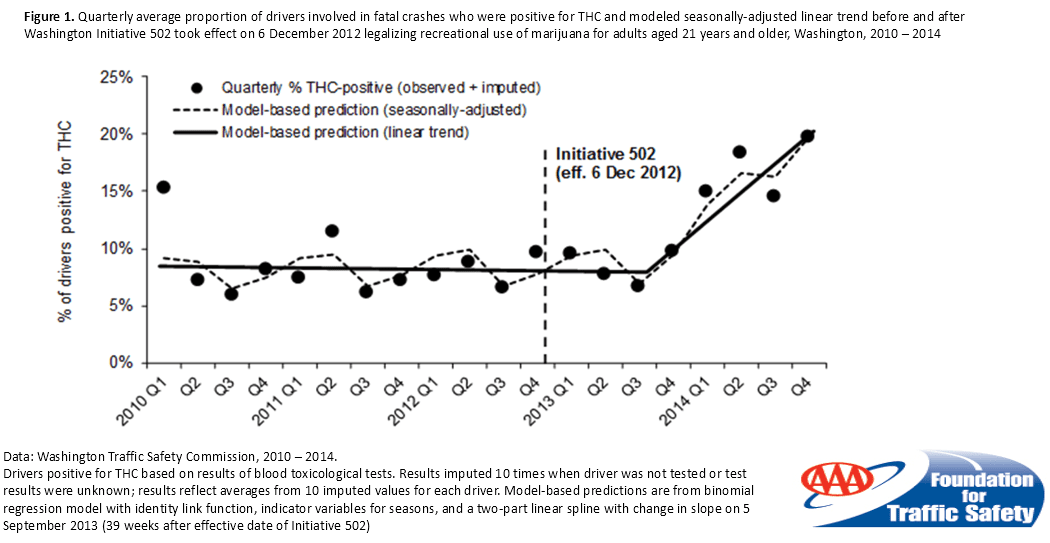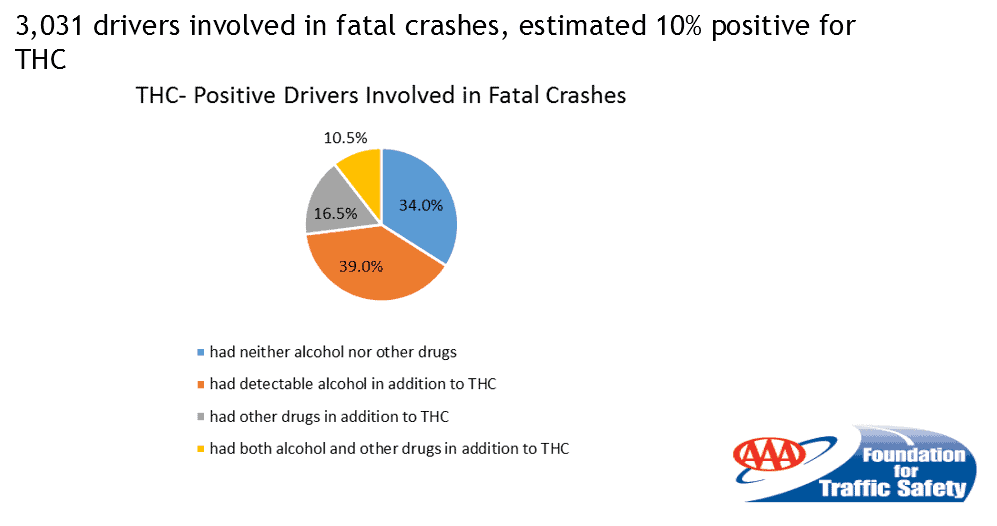The AAA Foundation for traffic safety ordered a handful of studies that assess the effects marijuana legalization had on driving safety. The studies arrived at a number of worrisome conclusions. Fatal crashes involving drivers who used marijuana doubled since the state lifted the ban. Also, researchers found the marijuana blood limit allowed for driving, known as per se limits, is arbitrary and not based on actual science.

Since November 2012, the state of Washington passed by popular vote the ballot Initiative 502 allowing adults over 21 to legally possess up to 1 ounce of marijuana for personal use. Overall, the new law proved extremely successful. Sure, the people wanted it, but it proved to be one of those laws whose social impact was unexpectedly positive. According to a report issued by the Drug Policy Alliance, since the passage of I-502:
- Filings for low-level marijuana offenses are down 98% for adults 21 and older. All categories of marijuana law violations are down 63% and marijuana-related convictions are down 81%.
- The state is now saving millions of dollars in law enforcement resources that were previously used to enforce marijuana laws.
- Violent crime has decreased in Washington and other crime rates have remained stable since the passage of I-502.
- Washington has collected nearly $83 million in marijuana tax revenues. These revenues are funding substance abuse prevention and treatment programs, youth and adult drug education, community health care services, and academic research and evaluation on the effects of marijuana legalization in the state.
- The number of traffic fatalities remained stable in the first year that adult possession was legalized.
- Youth marijuana use has not increased since the passage of I-502.
- Washington voters continue to support marijuana legalization. Fifty-six% continue to approve of the state’s marijuana law – about the same as when it was approved in 2012 – while only 37% oppose, a decrease of 7 points since the election of 2012. More than three-quarters (77%) believe the law has had either a positive impact or no effect on their lives.
Although DPA reports a stable number of traffic fatalities after the law was passed, one of the studies commissioned by the AAA Foundation seems to firmly disagree.
To this day, it’s still not clear what’s the prevalence of driving after marijuana use, but since January 2016 we know a bit better. The Washington Traffic Safety Commission (WTSC) issued a public database containing toxicology tests for THC performed on drivers involved in fatal crashes in the state of Washington.
From 2010 through 2013, the estimated number and proportion of drivers involved in fatal crashes who had a detectable concentration of THC in their blood ranged from a low of 48 (7.9%) to a high of 53 (8.5%). Both number and proportion doubled from 49 (8.3%) in 2013 to 106 (17.0%) in 2014. All other things being equal, the findings suggest that fatalities related to marijuana use doubled nine months later after I-502 was passed.
Take the outcomes with a grain of salt, though. Only 34% of the fatal crashes included in the WTSC database involved drivers who used only marijuana and nothing else.
It’s true, however, that marijuana significantly impairs judgment, motor coordination, and reaction time. So does alcohol, though. The state of Washington prohibits the operation of a motor vehicle by a driver that has a .08 percent or higher blood alcohol concentration (BAC). A similar prohibition was passed for marijuana use, namely drivers aren’t allowed to drive with more than 5 nanograms of THC per milliliter of blood.
Marijuana and THC don’t metabolize the same, though. A second AAA study found THC levels in the blood could not accurately predict driving performance.
The researchers used data from the police involving people arrested for driving under the influence of THC. Two types of tests are commonly used by law enforcement to gauge marijuana-related driving impairment. There’s the classic Standardized Field Sobriety Test where you have to walk down a line, touch your nose with the hand while one leg’s in the air etc. This so-called standard field sobriety test has been shown to catch 88 percent of drivers under the influence of alcohol. Then there’s THC blood measurement, that’s supposedly meant to gauge driving impairment in an objective manner.
When researchers compared the two test results for the same people, they found a substantial number of drivers who failed the THC tests actually passed the physical one. These findings seem to confirm a 2012 study published in the journal Psychopharmacology which found only 30 percent of people under the influence of THC failed the field test.
“All of the candidate THC concentration thresholds examined would have misclassified a substantial number of driver as impaired who did not demonstrate impairment on the SFST, and would have misclassified a substantial number of drivers as unimpaired who did demonstrate impairment on the SFST,” the researchers concluded.
In other words, some could take a toke and drive safely, yet fail the test and face criminal charges. At the same time, some would smoke, pass the THC test but obviously fail at driving. “Based on this analysis, a quantitative threshold for per se laws for THC following cannabis use cannot be scientifically supported,” the researchers say. The same is likely happening in Montana and Colorado, as well.
We need a better way to objectively gauge safe marijuana driving levels. Until then, the AAA urges law enforcement to stick to the Standardized Field Sobriety Test only.




